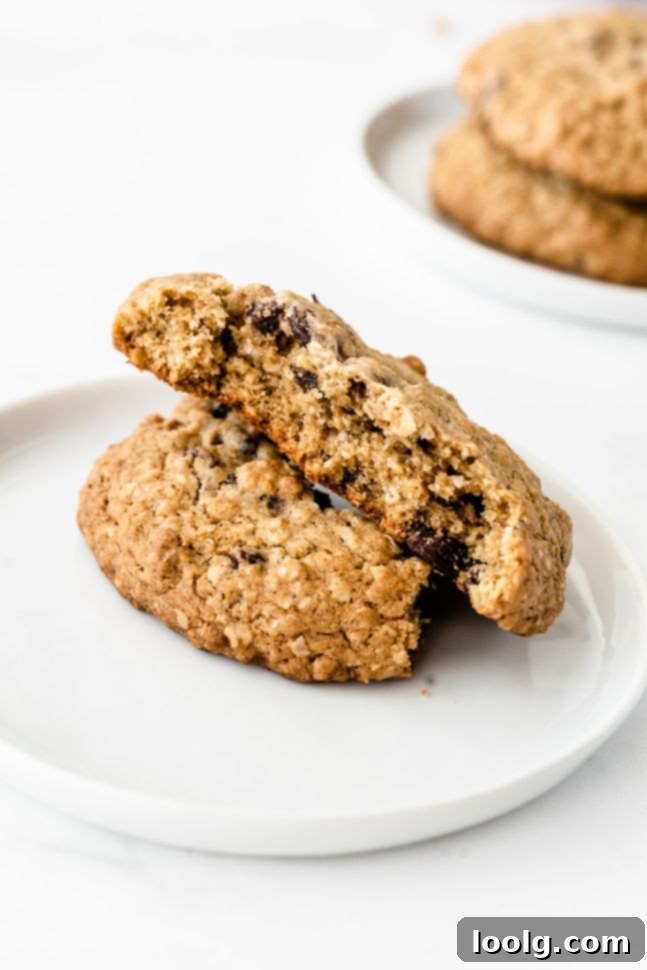Chewy & Delicious Butterless Oatmeal Cookies: Your Go-To Dairy-Free & Vegan-Friendly Recipe
Discover the ultimate recipe for oatmeal cookies without butter – a delightful treat that’s not only incredibly chewy and satisfying but also naturally dairy-free with a fantastic vegan option. Forget the fuss of a mixer or chilling dough; these butterless wonders come together by hand, making them perfect for any baker, from novice to expert. Whether you prefer regular flour, gluten-free, or whole wheat, this versatile recipe has you covered, promising a batch of cookies that taste even better than they look.
For many, oatmeal cookies evoke a sense of nostalgia, a comforting treat reminiscent of childhood and cozy autumn afternoons. There’s something undeniably classic about their hearty texture and warm, spiced aroma. If the weather in your area is still too warm for baking, don’t miss out on the goodness – try these no-bake oatmeal cookies for a cool alternative that also cleverly skips the butter!
As a self-proclaimed oatmeal cookie connoisseur (and yes, I’m laughing at myself too!), I can confidently say that these are truly perfect. They embody everything you want in an oatmeal cookie: a delightful chew, rich flavor, and a wholesome feel. The magic is in the texture, which is arguably superior to butter-based versions, offering an irresistible chewiness that will have you reaching for more.
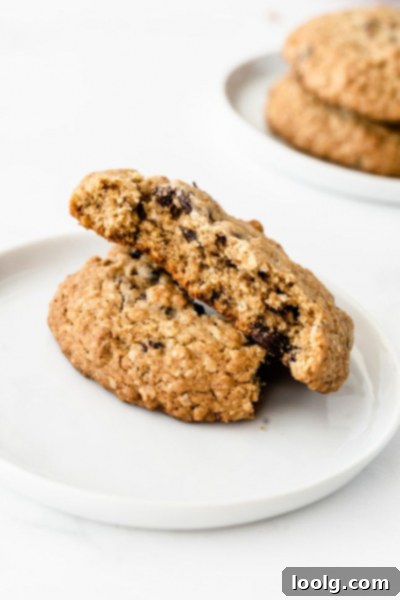
Choosing Your Oil: The Secret to Chewy Butterless Oatmeal Cookies
While traditional oatmeal cookies often feature butter, this recipe intentionally omits it, embracing various oils to achieve an exceptionally chewy texture. In fact, many find these oatmeal cookies are actually better without butter, as oil contributes to a more tender and pliable crumb. My personal favorite for these butterless oatmeal cookies is coconut oil, thanks to its neutral flavor (when refined) and excellent baking properties.
I’ve thoroughly tested this recipe with both refined and unrefined coconut oil. Surprisingly, even with unrefined coconut oil, which typically carries a distinct coconut aroma and flavor, I detected no noticeable aftertaste in the finished cookies. The generous amount of cinnamon in the recipe wonderfully masks any subtle undertones. This means you can confidently use whichever type of coconut oil you have on hand – refined for guaranteed neutrality or unrefined for its added nutritional benefits without compromising flavor.
Beyond coconut oil, other types of oil can also be successfully used. A light olive oil can work wonderfully, especially if you appreciate a subtle hint of its distinctive flavor. It might sound unusual for cookies, but the strong cinnamon presence in this recipe ensures the olive oil taste isn’t overwhelming, particularly once the cookies have cooled completely. It’s worth noting a peculiar phenomenon: straight out of the oven, cookies made with olive oil can sometimes have an odd, almost paint-like aroma. This is a common, though temporary, occurrence with some olive oil baked goods and typically dissipates entirely as they cool. I’ve encountered this before despite extensive baking with olive oil in other recipes, such as these Healthy Cinnamon Apple Muffins and Healthy Chocolate Cake. To minimize any olive oil flavor, I recommend using a light olive oil rather than extra-virgin, though I’ve found extra-virgin still yields delicious results once cooled, even if my husband couldn’t even detect the subtle hint.
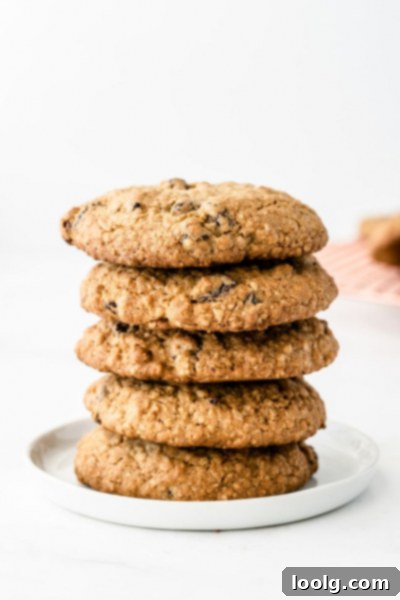
If olive oil isn’t your preference, other neutral oils like canola oil, grapeseed oil, or even sunflower oil are excellent alternatives that won’t impart any distinct flavor, making them ideal for these classic butterless oatmeal cookies. The key is to use a liquid oil that is melted if it’s solid at room temperature (like coconut oil), to ensure proper incorporation into the dough. This flexibility in oil choice ensures that you can always whip up a batch of these dairy-free delights, regardless of what you have in your pantry.
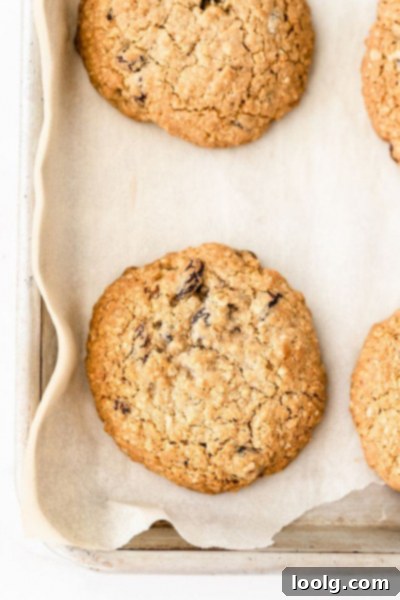
Effortless Vegan & Gluten-Free Adaptations for Butterless Oatmeal Cookies
One of the many strengths of this butterless oatmeal cookie recipe is how easily it can be adapted to suit various dietary needs, including making it completely vegan and gluten-free. Since the recipe already calls for oil instead of butter, you’ve already bypassed the primary dairy component, simplifying the vegan conversion significantly. The main adjustment for a vegan version involves replacing the two eggs.
For a flawless vegan alternative, I successfully used chia eggs in my tests, and the results were indistinguishable from those made with regular eggs. The cookies maintained the exact same taste and delightful texture. To prepare two chia eggs, simply combine 2 tablespoons of ground chia seeds with 6 tablespoons of water. Mix them thoroughly and let the mixture sit for about 5-10 minutes until it achieves a thick, gelatinous consistency similar to a beaten egg. While I haven’t personally experimented with other egg substitutes like flax eggs or commercial vegan egg replacers, it’s highly probable they would also work well, given the robust nature of this recipe. Chia eggs are particularly effective due to their excellent binding properties, which are crucial for holding the cookie dough together.
For those requiring a gluten-free option, this recipe is also incredibly accommodating. You have two main approaches. The first is to use a specific blend of gluten-free flours: a combination of white rice flour, potato starch, and tapioca starch, along with a touch of xanthan gum. Xanthan gum is vital in gluten-free baking as it mimics the elasticity and binding properties that gluten provides in traditional flours. Alternatively, you can opt for a high-quality 1:1 gluten-free baking mix designed to substitute all-purpose flour directly. I achieved fantastic results with Bob’s Red Mill 1:1 Gluten-Free Baking Flour, a brand I trust and frequently use in other gluten-free recipes like my healthy applesauce muffins and pumpkin cupcakes. While other brands might also perform well, I can only vouch for the one I’ve personally tested. Always ensure your oats are certified gluten-free if you are making these for someone with celiac disease or a gluten sensitivity, as conventional oats can be cross-contaminated during processing.
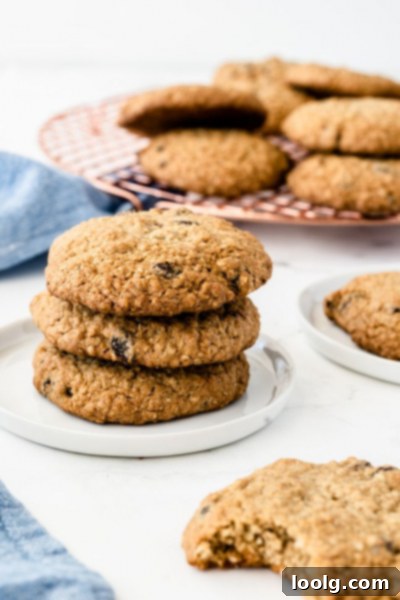
When it comes to add-ins, creativity is encouraged! While raisins are a classic choice for oatmeal cookies, feel free to substitute them with chocolate chips for a sweeter treat, or even a mix of both. Chopped nuts (pecans, walnuts), dried cranberries, or even white chocolate chunks would also be delicious additions. However, it’s crucial to stick to “dry” add-ins. I frequently receive questions about adding wet ingredients like zucchini or carrots, especially when people are overwhelmed with garden harvests! Unfortunately, wet ingredients will alter the moisture balance of the dough, leading to an entirely different and likely undesirable cookie texture. This recipe is specifically formulated for dry inclusions to maintain its signature chewy consistency. But if you are drowning in zucchini, I do think that’s a nice problem to have! Perhaps bake some zucchini bread instead!
Flour Alternatives: What Works and What Doesn’t
I’ve extensively tested this recipe with five distinct flour options – including all-purpose, whole wheat, white whole wheat, and two gluten-free blends (my custom mix and Bob’s Red Mill 1:1 GF baking flour). These are the only flours I can confidently recommend for successful results without altering the recipe’s balance. Substituting with other flours, especially those with significantly different absorption rates, can drastically change the cookie’s texture and spread. For instance, almond flour or coconut flour would require a complete re-evaluation and re-balancing of the wet and dry ingredients. If you’re keen on using spelt flour, I suggest checking out these dedicated Spelt Oatmeal Raisin Cookies, which are specifically formulated for that grain. While another 1-to-1 gluten-free baking mix *might* work, I cannot guarantee the same excellent results as the ones I’ve thoroughly tested.
Can I Substitute Oil with Other Ingredients?
This recipe is designed for oatmeal cookies without butter, leveraging oil for its unique texture benefits. While you *could* technically use butter if you prefer, please be aware that the cookies will likely be less chewy. They’ll still be tasty, but the distinct chewiness that oil imparts will be diminished. I strongly advise against using substitutes like applesauce, mashed bananas, or other purées as direct replacements for oil. These ingredients introduce a significant amount of moisture and require extensive recipe adjustments to maintain the correct dough consistency and final texture. You would likely end up with cakey cookies that spread excessively. For a truly healthy, oat-based breakfast cookie, consider exploring recipes specifically developed for those ingredients, like these Healthy Oatmeal Breakfast Cookies, which are designed from the ground up to be nutritious and delicious with alternative binders.
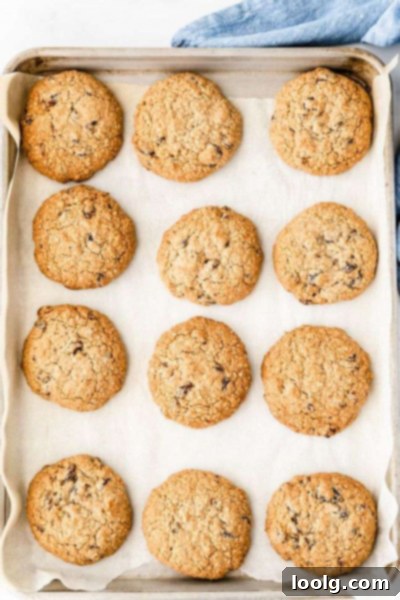
Common Questions About Our Butterless Oatmeal Cookies
Can You Taste the Coconut Oil?
A common concern when using coconut oil is whether it will impart a coconut flavor. In this recipe, even when using unrefined coconut oil, neither I nor my taste testers could detect any coconut flavor in the finished cookies. The rich blend of spices, particularly the cinnamon, effectively neutralizes any subtle coconut notes, allowing the classic oatmeal cookie flavor to shine through.
What About Other Vegan Egg Substitutes?
While I exclusively tested with chia eggs for the vegan version of these butterless oatmeal cookies, I am confident that most common egg substitutes would likely work well. This recipe is quite forgiving, and the oats themselves provide a good amount of binding. Flax eggs (1 tablespoon ground flaxseed + 3 tablespoons water per egg) are a popular and reliable alternative that should perform similarly to chia eggs. Commercial vegan egg replacers designed for baking are also usually effective.
Can I Use Different Sweeteners?
This recipe calls for granulated sugars like brown sugar or coconut sugar. You can generally substitute with other granulated sugars that measure and behave similarly to regular white granulated sugar. However, liquid sweeteners such as maple syrup, honey, or agave nectar are NOT recommended. Liquid sweeteners would significantly alter the moisture content of the dough, making it too wet and leading to cookies that are overly cakey and spread excessively during baking. For the best texture and flavor, stick to the specified granulated sugars.
Can I Reduce the Sweetener or Oil?
While it might be tempting to reduce the amount of sweetener or oil for dietary reasons, I’ve carefully calibrated this recipe to use the minimum amount necessary for optimal texture and flavor. Reducing either ingredient further will likely result in cookies that are noticeably drier, more cakey, and crumbly. The cookies, as written, are not overly sweet, striking a perfect balance. If you are seeking a truly healthy, less sweet oat-based treat, I recommend trying recipes specifically designed for that purpose, such as my Healthy Oatmeal Breakfast Cookies, which prioritize nutritional value and a lower sugar content.
What About Different Add-ins or More Add-ins?
Feel free to get creative with your add-ins! Nuts (walnuts, pecans, almonds), other dried fruits (cranberries, chopped apricots), or even candy pieces (like M&M’s or toffee bits) work wonderfully. As mentioned before, the golden rule is to use “dry” add-ins only. Avoid anything with high moisture content like shredded zucchini, carrots, or fresh fruit, as these will disrupt the dough’s consistency and the final cookie texture. It’s also important not to go overboard with the quantity of add-ins. Adding too many can prevent the dough from holding together properly, making the cookies fall apart. Stick to the recommended amount for the best results!
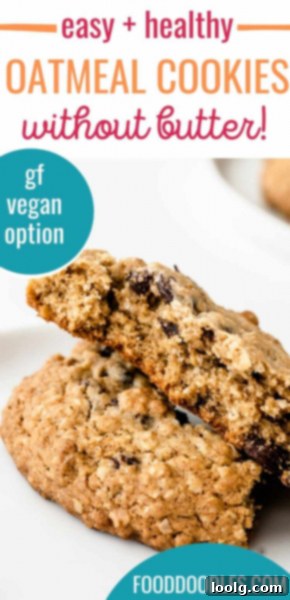
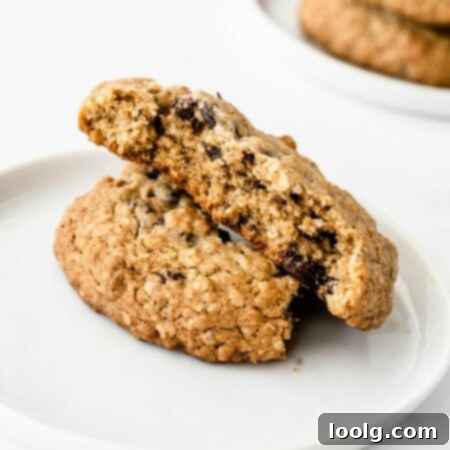
Oatmeal Cookies without Butter
Ingredients
- 1 1/2 cups (190 grams) all-purpose flour, whole wheat flour or white whole wheat flour OR for gluten-free, use the mix listed in the notes* or Bob’s Red Mill 1:1 Gluten-free Baking Flour
- 1 teaspoon baking soda
- 1 teaspoon baking powder
- 1/2 teaspoon salt
- 1 teaspoon cinnamon
- 3/4 cup (168 grams) melted coconut oil OR another oil (see post for more notes)
- 1 1/3 cups (266 grams) brown sugar or coconut sugar
- 2 large (50 grams each, out of shell) eggs or 2 chia eggs for vegan**
- 1 tablespoon vanilla extract
- 2 3/4 cups (260 grams) quick oats (use GF oats for a GF version)
- 1 1/4 cups (190 grams) raisins or chocolate chips
Instructions
-
Preheat the oven to 375°F (190°C) and line a cookie sheet with a piece of parchment paper.
-
In a medium mixing bowl, whisk together the flour, baking soda, baking powder, salt, and cinnamon. Set aside.
-
In a large mixing bowl, thoroughly combine the melted coconut oil (or other chosen oil), brown sugar (or coconut sugar), eggs (or chia eggs), and vanilla extract. Whisk until smooth.
-
Gradually add the dry flour mixture to the wet ingredients, stirring just until everything is combined and no streaks of flour remain. Fold in the quick oats and raisins (or chocolate chips), mixing gently until evenly distributed. Be careful not to overmix.
-
Scoop the dough into approximately 1/4 cup (75-gram) balls, which should be about two inches in size, and arrange them about 4 inches apart on the prepared baking sheet. Lightly flatten each ball with the palm of your hand. If your dough is too soft or sticky to roll, refrigerate it for about 30 minutes, or until it becomes firm enough to handle and scoop.
-
Bake for 13-17 minutes, or until the centers of the cookies appear set and the edges are beautifully golden brown. Baking times can vary depending on your oven, so keep an eye on them!
-
Once baked, let the cookies cool completely on the baking sheet. This is crucial for achieving their ultimate chewy texture and preventing them from breaking. Store cooled cookies in an airtight container at room temperature for up to 5 days. For longer storage, they can be frozen for several months; simply thaw at room temperature before enjoying.
Notes
- To make these cookies gluten-free, use the following instead of the flour listed in the recipe:
- 1 cup (140 grams) white rice flour
- 1/3 cup (52 grams) potato starch
- 2 tablespoons + 2 teaspoons (20 grams) tapioca flour
- 1/2 teaspoon xanthan gum
** To make 2 chia eggs, mix 2 tablespoons ground chia seed with 6 tablespoons water. Mix until combined and gloopy like an egg.
These butterless oatmeal cookies are more than just a sweet treat; they’re a testament to how simple ingredients can come together to create something truly special. Whether you’re navigating dietary restrictions or simply looking for a new twist on a classic, this recipe delivers on all fronts: incredible flavor, satisfying chewiness, and effortless preparation. So go ahead, whip up a batch, and enjoy the wholesome goodness of these delightful dairy-free and vegan-friendly oatmeal cookies!
